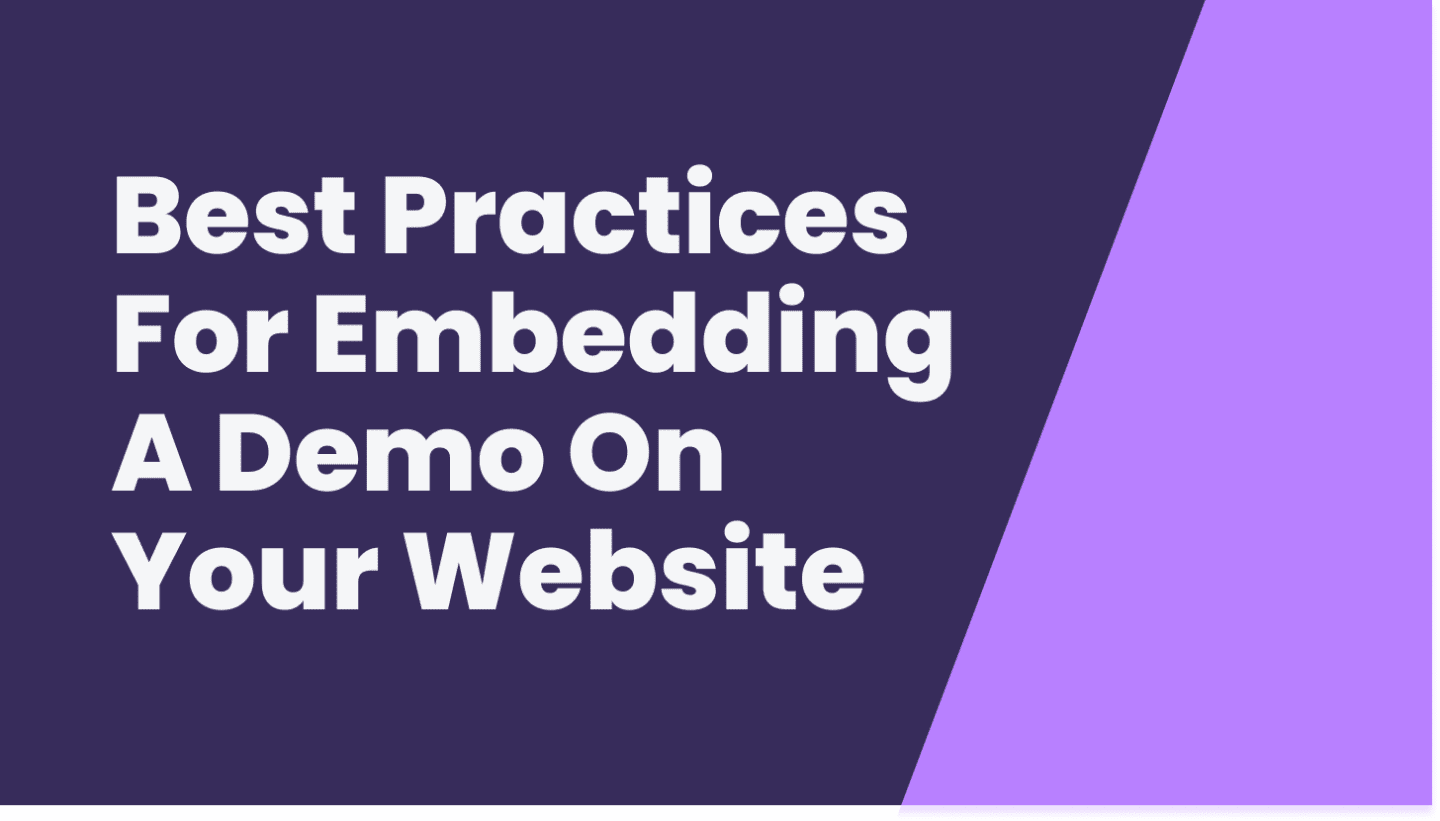Updated February 8, 2024.
Let’s cut to the chase.
You’ve stumbled across this Walnut blog because you want to know what you need to do to meet your sky-high quota this Q.
Well, you’ve come to the right place.
To close more deals, you need to be able to nail the most crucial part of the sales process: the sales demonstration.
That’s why we put this article together to break down everything you need to know about delivering killer sales demonstrations.
- What is the definition of a sales demonstration?
- What is the difference between a sales demo and a product demo?
- Why sales demonstrations are important
- Sales demo basics
- Why give a sales demo?
- When should you give a sales demo?
- Who gives a sales demo?
- How can you give a sales demo?
- Benefits of using sales demonstrations
- Explain how your product works
- Showcase value
- Qualify leads and enhance buying intent
- How to structure your sales demos to make an impact
- Learn to speak their language
- Structure the sales demo
- Make an impact
- Best practices for delivering a sales demonstration that converts
- Start the sales demo on a high note
- Focus on value
- Keep your sales demonstration short and sweet
- Keep your audience engaged from start to finish
- Mind your manners
- How to create a winning sales demonstration
- Using sales demonstrations to enhance your B2B sales strategy
What is the definition of a sales demonstration?
Before we dive right into the details, let’s make sure we understand what a sales demonstration is.
A sales demonstration (AKA a sales demo) is the part of the B2B sales process when a sales rep presents the product to a prospect in order to showcase its value and benefits.
A successful sales demo will help the prospect understand how the product can address their unique pain points. It will also position the product as the best option on the market to achieve the prospect’s goals.
What is the difference between a sales demo and a product demo?
At this point in the article, you might say to yourself, “Well, a sales demo sounds exactly like a product demo.”
And you’re not wrong for thinking this.
They are very similar in that both demonstrate how a product addresses pain points and position a particular product as superior to the rest of the competition.
That being said, there is a significant difference between them.
A sales demo is only given to prospects during the buying process. Meanwhile, a product demo is given to both potential and existing customers.
Why sales demonstrations are important
You may just have the best SaaS product in the whole entire world.
(WOAH, that’s pretty darn impressive, if we don’t say so ourselves.)
That being said, no matter how awesome your product is, if you can’t showcase that awesomeness to buyers, your sales numbers will suffer. And this is why the sales demo is so critical to your sales team’s success.
The sales demonstration lets you show your prospects that you understand their pains and have a solution that will save them time, money, frustration, or some combination of all three.
More often than not, the quality of your sales demo is usually the difference between closing a deal or not.
So, in order to boost your win rate and drive revenue growth, you need to make sure you’re presenting your product in a way that resonates with your prospects.
Sales demo basics
Even though we’ve got the definitions down pat, let’s quickly go over some more basics before we go any further.
Why give a sales demo?
You wouldn’t buy a car without taking it for a test drive, right?
Well, the same goes for buying software.
Software buyers want to be able to try out your product for themselves and get a sense of whether or not it will really address their pain points. Plus, when done right, sales demos allow you to showcase how your product is better than the competition’s solution.
When should you give a sales demo?
It used to be that sales demonstrations would take place towards the end of the sales process.
If we look at the traditional sales funnel, demos would typically happen in the Decision phase.
But this is old school SaaS sales.
Nowadays buyers want to see the sales demonstration from the moment they start the buying journey.
If you use an interactive demo platform (like Walnut), you’ll be able to let prospects see your demo whenever it works for them.
With an interactive demo platform, you can show your demo earlier in the process by embedding on your website or including the demo in your outbound communications.
But this is just the tip of the iceberg. Interactive sales demos can be used at any point throughout the funnel, whether it’s during the Awareness phase all the way through internal training.
For some inspiration on all the different ways to use sales demonstrations, check out our use case library.
Who gives a sales demo?
Typically, a sales rep will give a sales demo to prospects.
That being said, a solutions engineer will sometimes join them on the call to help with the technical side of things.
However, if you are using an interactive demo platform (like Walnut), then you can send your prospects interactive demos so they can view them on their own time. Plus, they can share these demos with other decision-makers within the organization.
How can you give a sales demo?
When it comes to presenting a demo, there are tons of ways you can do it.
But not every type of demo is created equal.
The different ways to give a sales demo include:
- Interactive sales demos
- Pre-recorded videos
- Slide decks
- Live sales demos
Having said that, only interactive sales demos make it easy for you to personalize the buying experience and show how your product will meet buyers’ needs.
Benefits of using sales demonstrations
If at this point, you find yourself saying, “That all makes sense. But what do I really get out of using sales demonstrations?”
Well, to that we would say, “Quite a lot.”
Here are just some of the things that sales demonstrations can help you do:
Explain how your product works
When it comes to selling SaaS, the golden rule is to show, not tell.
We mean that it’s better to let your product do the talking and let it sell itself. And that’s where sales demonstrations come in.
Instead of listing out what your software can do, sales demonstrations allow you to showcase exactly how a product works and why prospects should care.
And if you’re using interactive demo software to create your sales demonstrations, you can give prospects the power to freely click through and get a true-to-life experience with your product. This in turn, can speed up the time it takes for them to understand what your product can do.
Showcase value
Sales demonstrations don’t just give you the ability to show how your product works.
They also let you highlight the product’s unique value proposition.
This is especially true if you are using an interactive demo platform. Because interactive sales demos let prospects experience the product at their own pace, they can spend more time on the parts that interest them and skip the parts that are less relevant.
On top of this, interactive demo platforms allow you to personalize your sales demonstrations based on a particular prospect’s needs and pain points.
And by showing only the parts of the product that are relevant for them, you make it easier for the prospect to understand the value they can gain and what it would be like to actually use it in their day-to-day lives.
Qualify leads and enhance buying intent
If you use sales demonstrations from the beginning of the sales process, they can even help you qualify leads.
How, you ask?
Well, by embedding a sales demonstration on your website or sending it in your outreach, you allow prospects to see your product right off the bat.
And if you use an interactive demo platform to make your sales demos, you’ll be able to see which parts of the demo buyers spent the most time on and which parts were less interesting for them.
This information can then be used to qualify your leads and help you better focus your future conversations with the prospect.
On top of this, showing your product from the outset can help you ensure that the leads meeting with your team have high buying intent. This is because buyers have already seen your product from the beginning, so they already have a sense of what it can do before they meet with your team. This ensures that your team is investing their time and resources in the right prospects.
How to structure your sales demos to make an impact
When it comes to structuring your demo, it needs to be less about your product, and more about the buyer. This involves creating a vision of what your product will specifically do for them.
Let’s dig a little deeper and break this down even further.
Learn to speak their language
Do some research prior to your call to ensure you will be able to relate to buyers and speak their language.
You don’t need us to tell you to go through their website and learn more about what they are selling, who the leaders of their company are, and their competitors.
However, in addition to that, dig a little deeper into who they might be targeting, and which industries they are looking into. Do they target companies of a particular size, or in a particular location? What’s the department or the role of your prospect’s prospect? What are some obstacles your prospect may be facing, and how can your product help overcome them?
Having a good sense of these insights will help you take on the most ideal approach in demonstrating (in a well-rounded manner) that your product is the best solution to their pain points, and that you and your team are really on top of things.
Structure the sales demo
Once you’re comfortable with the approach you’re going to take, email your prospect to let them know of the structure of the presentation itself.
We recommend this so they can know what to expect beforehand. In the email, be sure to confirm the date, time, and duration of the call.
While writing out the structure, we highly recommend you spend more time listening to them, and less time talking.
After that, go over the most interesting product highlights that would be relevant for your prospect, followed by the application. Last but not least, spend the rest of the time doing a Q&A, a quick wrap-up, and going over next steps.
Make an impact
There are two important points you must always remember for sales demos:
- You must be naturally conversational, so you don’t come off as a salesy robot in your delivery.
- Your prospect isn’t in it to buy your features or your tech. They are in it to buy a solution for their woes, from a company and contact they can trust.
Make your mark by showing your prospect all that you learned about them, their company and their industry pain points. By demonstrating your fluency in their industry trends, vocabulary, titles, competitors, etc- you will further establish your credibility and strengthen the connection.
Also, bear in mind that you do not have to succumb to the pressure of completing the planned demo path, or even ultimately following it at all for that matter.
When push comes to shove, let the natural flow of the conversation ultimately lead the way, to ensure the most impactful and meaningful call for both you and your prospect.
Best practices for delivering a sales demonstration that converts
That’s all fine and good. But how exactly can you make sure your sales demonstration will win over your prospects and ultimately lead them to convert?
Well, that’s exactly what we are here to help you with.
We’ve rounded up some of the best tips and tricks in our playbook to help you deliver a deal-winning sales demonstration.
1. Start the sales demo on a high note
Your prospects’ attention spans aren’t getting any longer.
That’s why we recommend leaving out generic steps like signing up, inviting colleagues, or anything else that is not unique to your product. Instead, focus on showing them the most interesting and relevant value.
There’s nothing worse than being in a demo where the first 10 minutes are spent just talking about the company. In these kinds of demos, there’s a good chance that prospects will have zoned out and started thinking about what they are eating for lunch by the time the rep starts talking about the product.
This is why it’s so critical to start with the best reason that the prospect needs your product, and then spend the rest of the demo showing them other features that could be useful for their needs.
2. Focus on value
For the sales demonstration to succeed, you need to convince buyers that they will gain value from using your product.
And the way to do this is by letting the product do the talking.
We want to clarify though, that this doesn’t mean showing them feature after feature.
You need to take everything you know about the prospect and show them only the features that they need to address their pain points. So, once you identify the parts of the product that are most relevant for their needs, focus just on those features and the value they can gain from them.
3. Keep your sales demonstration short and sweet
When it comes to sales demos, short and sweet is the name of the game.
Like we mentioned earlier, your prospects’ attention spans aren’t very long. Not to mention, according to Walnut’s product report, on average, buyers spend only 6.5 minutes viewing each demo.
That’s why we recommend creating short and personalized interactive sales demos that keep things straightforward and to the point by showing only the most important features for that particular prospect.
4. Keep your audience engaged from start to finish
It’s not enough to just grab your prospects’ attention at the beginning of the demo.
You have to make sure that they remain engaged and interested from start to finish.
To keep your buyers engaged throughout your entire sales demo, it’s a good idea to call them out by name and consistently check in with them to make sure you’re showing them the parts of the product that are the most important for their needs and use cases.
We also recommend asking them questions as you progress through the sales demonstration.
5. Mind your manners
We know you have sky-high quotas to meet and just want to close this deal and move on to the next.
But at the end of the day, your sales results will suffer if you don’t remember to mind your manners.
Rather than just blabbing away, you need to actually listen to your prospect and make sure you really understand their needs. If there’s any uncertainty, ask them questions to get to the heart of the challenges they’re facing. Then you can offer your advice on how they can address these issues.
And if they have any objections, make sure you really understand their concerns before you respond.
Even if you need to get back to them at a later time, they’ll appreciate that you are taking the time to understand and address their concerns rather than trying to force the product down their throats.
It could also be that your product just isn’t a fit for them right now. But that’s ok. Being honest and upfront will make it much more likely that they’ll come back at some point when the timing is better.
If you don’t wanna take our word for it, take Samantha McKenna’s. The CEO and founder of #samsales Consulting told us that one of the worst mistakes you can make in sales is “not paying attention to your manners.”
How to create a winning sales demonstration
So, how exactly do you go about making a killer sales demonstration?
Well, if you’re using an interactive demo platform like Walnut, it’s actually pretty easy.
To build a sales demo that’ll have your prospects falling in love with your product, all you need to do is follow these steps:
Step 1: Capture your product’s screens.
First off, you’re going to need to capture the screens of your product.
Remember, you don’t need to capture each and every feature your product has to offer. Instead, focus only on the parts that are relevant for the specific prospect you’re going to give the sales demo to.
Step 2: Personalize your interactive sales demo for your prospect.
In case it wasn’t clear enough, we’ll say it again: generic demos suck!
So, make sure you personalize your sales demo with the prospect’s logo, name, and brand style elements. And of course, customize the demo to show only use cases or verticals that they are interested in.
Step 3: Add guides.
By adding guides to your demo, you can create the perfect flow you’d like your prospect to follow and make sure they get the most out of your demo!
This way, your prospect will be able to explore your product by themself before, during, and even after the demo call.
That’s it! Easy peasy lemon squeezy.
(What even is that saying?)
Using sales demonstrations to enhance your B2B sales strategy
You wouldn’t buy a new bike without first taking it for a spin, right?
Well, for most people, the same goes for new software.
Modern SaaS buyers want to not only see your product, but also test it out before committing to spend their company’s limited budget on it.
That’s why the sales demonstration is so important. It’s your chance to make a good first impression on the buyer and convince them that your product is exactly what they need to address their pain points.
And if you use interactive demo software like Walnut, it’s easy to create and deliver interactive sales demonstrations that can be personalized based on use case, vertical, or any other need a prospect may have. Not to mention, demo platforms (like WALNUT) let you analyze your demo performance so you can understand how to make improvements to demos going forward.
If you want to learn even more about how to make winning sales demonstrations, click ‘Get Started’ now!



